16 Vinegar Hacks For A Cleaner Kitchen
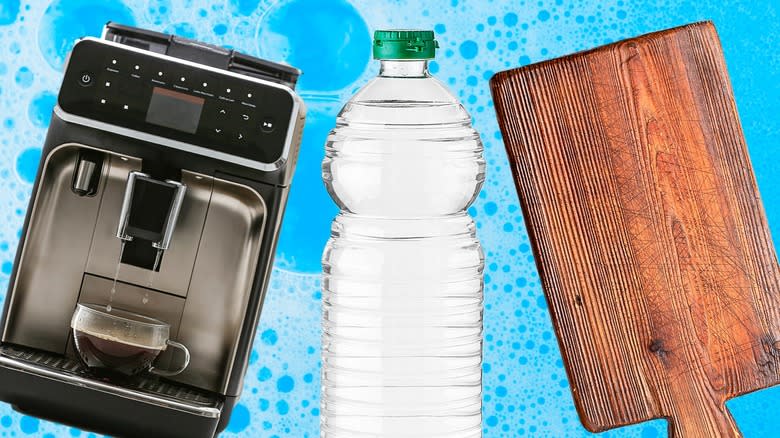
Vinegar is a powerhouse when it comes to keeping your home pristine. This humble kitchen staple, which can be abrasive and tough on grease without the use of harsh chemicals, offers a plethora of benefits as a cleaning agent. This makes it a versatile and eco-friendly solution for tackling dirt, grime, and germs. Plus, vinegar can kill some types of bacteria without posing a risk to human health. Moreover, vinegar's versatility extends beyond the kitchen; it can be used to clean windows, mirrors, and glass surfaces, leaving them streak-free and sparkling. Its acidic properties also make it an excellent deodorizer.
One of the most appealing aspects of vinegar as a cleaning agent is its affordability and accessibility. Vinegar is inexpensive and readily available in most households. Furthermore, using vinegar for cleaning is environmentally friendly, as it is biodegradable and can be safely ingested, unlike other types of commercial cleaners. By opting for vinegar as a cleaning agent, you can keep your space tidy and create a safer, healthier home environment for you and your family. So, let's take a look at how best to deploy vinegar outside of using it in a recipe.
Read more: 11 Cleaning Tips For Keeping Your Oven Spotless
Mix Up An All-Purpose Cleaner
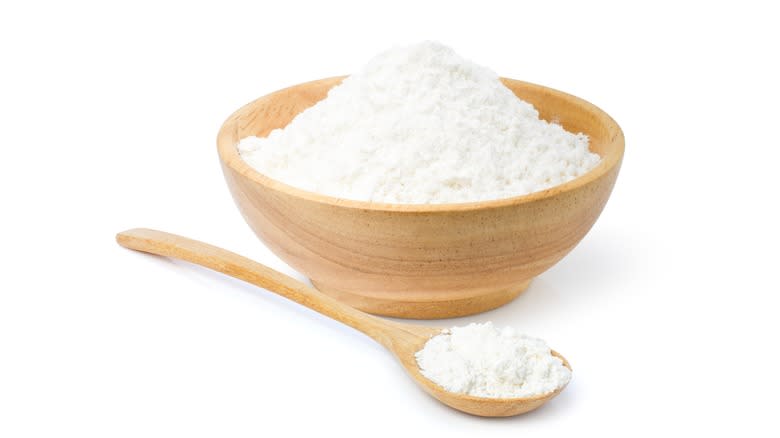
Harness the power of vinegar by combining it with other ingredients to make your own all-purpose cleaner. The recipe is simple; use ½ cup of vinegar for each ½ cup of water, and mix in 2 tablespoons of baking soda. Whip up a big batch, put it in a spray bottle, and grab it every time you need to clean up your kitchen -- bearing in mind that highly acidic substances like this cleaner can damage some natural stone surfaces.
You might be wondering about the smell of the ingredients. Indeed, large quantities of vinegar can make a room smell a bit sour. But there's a hack for that, too. Mix your favorite fragrance ingredients with the solution and let the mixture infuse for a couple of weeks, shaking the container every few days. Lavender flowers might be a nice addition, while lemon peels and mint leaves are also popular choices. Just remember to strain them out of your vessel before you start using the cleaner. Otherwise, they might clog the nozzle.
Clean Your Coffee Maker
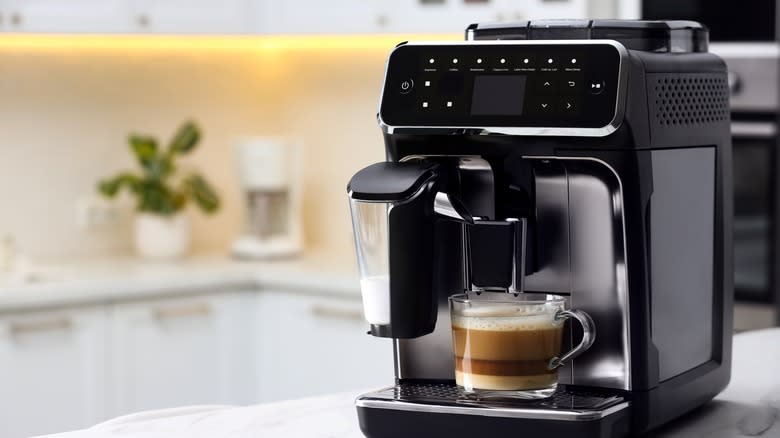
Many people don't think to clean their coffee makers simply because the only thing they use them for is coffee, so there's no risk of flavors getting mixed up or rubbing off on each other. The problem is that coffee makers have a lot of closed spaces that can quickly accumulate moisture, which in turn can lead to the proliferation of mold and bacteria. To make things even more complicated, coffee makers can't be shoved into a dishwasher.
Distilled white vinegar is here to the rescue. To reap its benefits, you must pour it directly into the coffee maker's water container. This area gets particularly gross, so it's best to let the vinegar sit here for a good 30 minutes. After that, it's time to brew the world's most sour cup of coffee -- sans the coffee beans. Switch on the coffee maker so that all that vinegar can pass through the machine, cleaning all the components along the way. To ensure your machine is ready to brew again, rinse everything with water once or twice before you go back to making coffee.
Make Your Wine Glasses Sparkle

When you've gone all out to decorate your table for a fancy dinner party, the last thing you need is to find your glassware smudged with soapy streaks from its last wash. Cloudy wine glasses will quickly turn a sophisticated affair into a dive bar scenario.
Luckily for those who noticed this oversight at the last minute or right before the guests arrive, we have a quick solution that involves a readily available household product. Just fill a container with hot water and some drops of white vinegar, then plunge your wine glasses into the solution, rinse them with hot water, and wipe them dry with a soft cloth. You'll get crystal clear wine glasses that are ready to hand out to your guests in a matter of minutes. That little bit of vinegar in the water will instantly pull off any residue. You can even throw baking soda into your solution for those extra-tough streaks and stains.
Spray Your Fruit
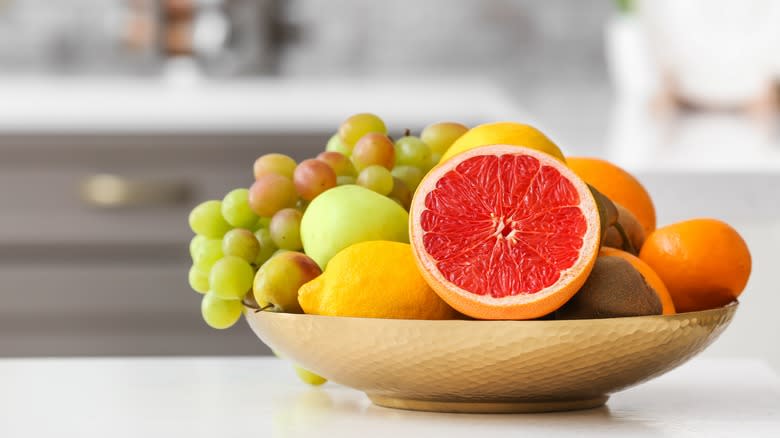
Salmonella, E. coli, and other foodborne illnesses are always lurking where we least expect them, including on our fruit. This is why it's important always to rinse your produce before you consume it, especially if you plan on eating it raw. Doing so will help remove any pesticides, dirt, or grime from the soil or the people handling it as it transitions from the farm to the grocery store aisle or market stall. Although a thorough wash is already a part of this process, it's not infallible, as a little bit of salmonella can go a long way.
The thing is, simply passing your produce under running water isn't always enough. You may want to create a diluted vinegar soak or spray for your fruit, depending on the produce you're working with. Large, dense fruits like apples or peaches will only need a quick spray of the solution before you rinse it and eat it, while porous produce like berries can use a good three-minute soak. Be sure to allow everything to air dry before you store it. Ideally, you'll want to rinse your fruits right before consuming them, as prolonged exposure to water can cause them to grow mold quickly.
Turn Vinegar Into A De-Ruster For Your Cast Iron Skillet
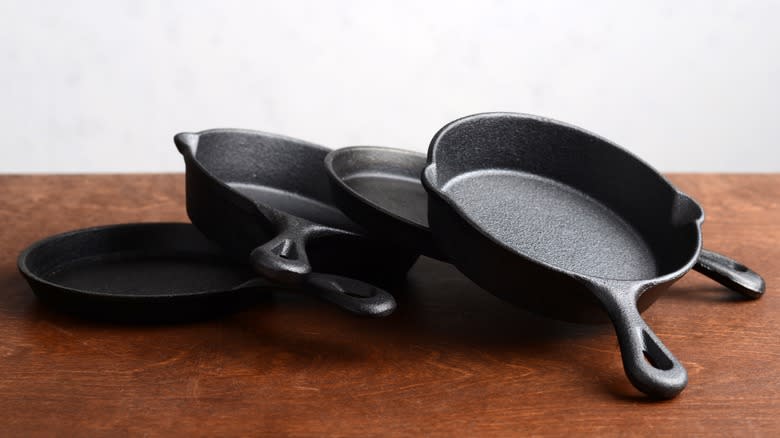
If the apocalypse comes and you only have time to grab one pan before you run for the hills, let it be a cast iron skillet -- since it's the most useful and versatile pan there is. It can cook practically anything evenly, all while boasting natural non-stick qualities. In short, everything cooked in a properly seasoned cast iron skillet seems to taste better.
Cast iron is notoriously prone to rusting if it's improperly stored. But this rust is no reason to throw the pan away. All you have to do is soak it in a vinegar and water solution to dislodge the rust, making sure not to pour in so much vinegar that the healthy iron also starts to erode. For the same reason, it's best not to let the pan soak longer than an hour or so. Then give the pan a good scrub before you rinse, dry, and re-season it.
Degrease Your Oven
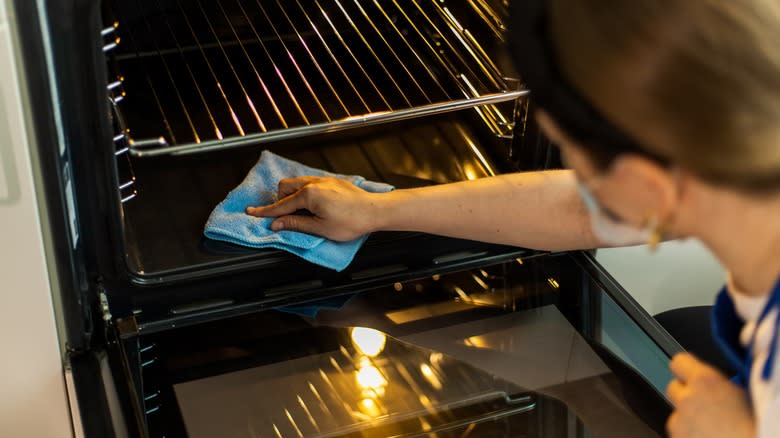
Oven cleaning is not a task people jump for joy about having to do. Once the door is closed and the rest of the kitchen is clean, it's easy to forget that there's a whole world of food scraps in there that gradually build up as you become more and more lenient on your oven cleaning routine. But things don't have to be this way. We can give you an oven-cleaning hack that is so simple and easy that you'll never procrastinate on this task again.
The hack involves putting your appliance through a quick vinegar steam. Just place a mixture of water and vinegar in an oven-safe bowl, set your oven on high, and once your solution starts to bubble, you'll know the process is underway. The steam will start to rise and overtake every corner of your oven, working on any residual grease and grime. Be sure to turn off your oven shortly after that and leave the door closed for a good 30 minutes before you open it to wipe off the grease.
Give Your Dishwasher A Vinegar Cleanse
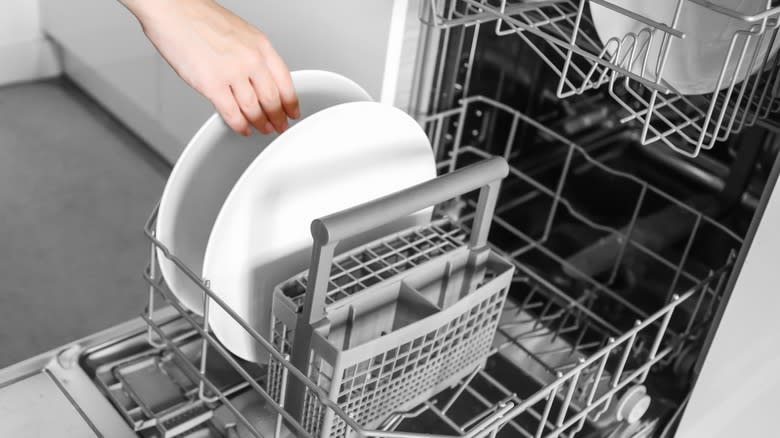
It may seem redundant to clean a dishwasher. Why wash something that already seems to clean itself every time it runs? The truth is that those bits of grease and dirt coming off your dishes don't just disappear into thin air. Many of them stick around, and if they're not removed by hand, they may end up clogging your appliance.
Luckily, the process of cleaning your dishwasher isn't complicated. Start by taking out the bottom rack and picking out any visible food scraps from the drain. Then, place a dishwasher-safe container of vinegar in the top rack and run a hot water cycle. This will allow the vinegar to gnaw away at the grime that has been lingering in the appliance. At this point, you might also want to wipe away any debris you see that has accumulated in the nooks and crannies of the dishwasher, like in the corners where the door closes. This alone should get rid of grime and odors, but if you want to take it one step further, you can also sprinkle baking soda on the bottom and rerun the hot water cycle.
Remove Grease From The Cabinetry
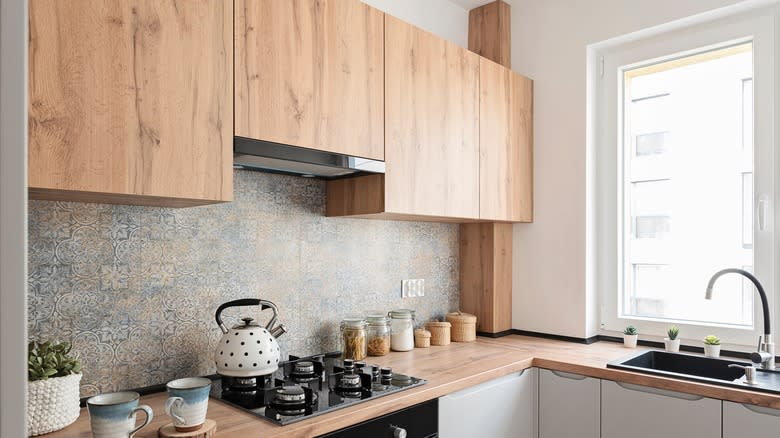
For many people, "cleaning the kitchen" means wiping down the stove, countertops, and sink. These are the areas that see the most amount of action and where dirt tends to be most visible. But while you cook, grease will inevitably rise up and stick to vertical surfaces as well, or even upside-down ones, like the bottom of your top cabinets or vents. Food splatters can be just as pesky.
So next time you go about cleaning your kitchen countertops, spare a thought for your cabinetry. Run your fingers down them and see just how greasy they are. If they haven't been wiped in months, chances are that you'll end up with an unsightly smudge. Clean that nasty grease off kitchen cabinets with a vinegar and water solution. Be sure to clean the cabinets' undercarriage as well. This may seem like a daunting task, but if you undertake it every week, you'll just be dealing with a light, easily wipable film.
Keep Your Ice Maker Sparkling
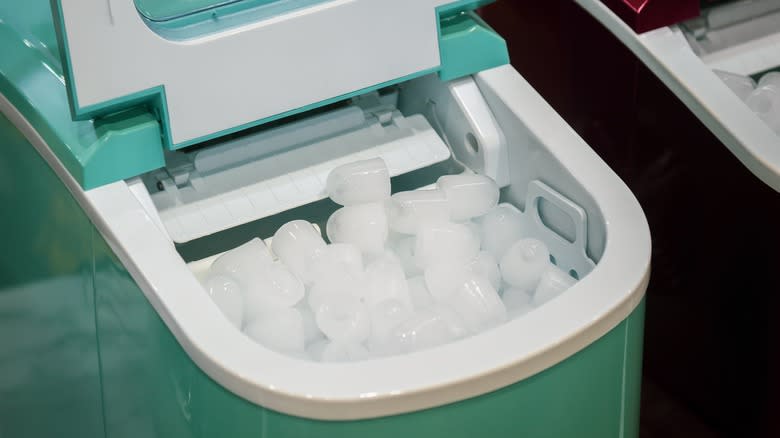
If you're lucky enough to have a countertop ice maker, you should also know that these appliances need to be cleaned every three to six months. If the ice looks splotchy, or if it smells or tastes stale, then you know it's time for a good cleaning.
Now, because ice makers contain ice that you'll presumably be using in your drinks, harsh chemicals are not ideal for cleaning them, as they can introduce toxic elements into your system. Rather, go for a mixture of equal parts water and white vinegar. Put this into a spray bottle and spray the ice maker inside and out while you soak its removable parts in the same solution. To finish, scrub everything down, rinse the component parts, and assemble the ice maker. If the first batch of new ice tastes too vinegary after the cleaning, run it through a few more cycles until you get a clean batch.
Remove Germs From Your Wooden Cutting Boards
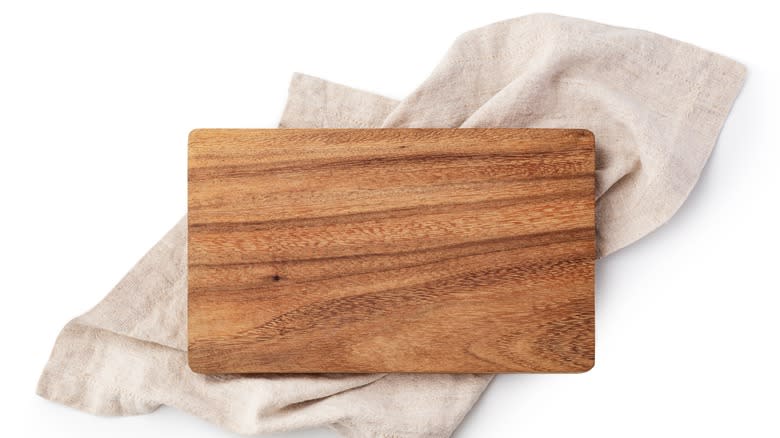
Wooden cutting boards are a marvelous kitchen tool -- they're attractive, long-lasting, and naturally antibacterial. But that doesn't mean they're completely immune to bacterial growth. It's recommended that people use at least two different cutting boards, one for meat and fish and the other for ready-to-eat foods. This will help prevent raw foods from being contaminated with dangerous bacteria found in raw meat.
The risk of dangerous microbes is just one reason why you need to disinfect your cutting boards frequently -- even the wooden ones. And while some outlets will recommend using bleach for this, natural products can work just as well without the added risk of ingesting bleach. In particular, you can use peroxide and baking soda to sanitize your wooden cutting boards, followed by a few spritzes of vinegar to deodorize the surface. This kitchen cleaning hack is simple and will ensure your boards are safe to continue using.
Prevent Stains On Your Countertops
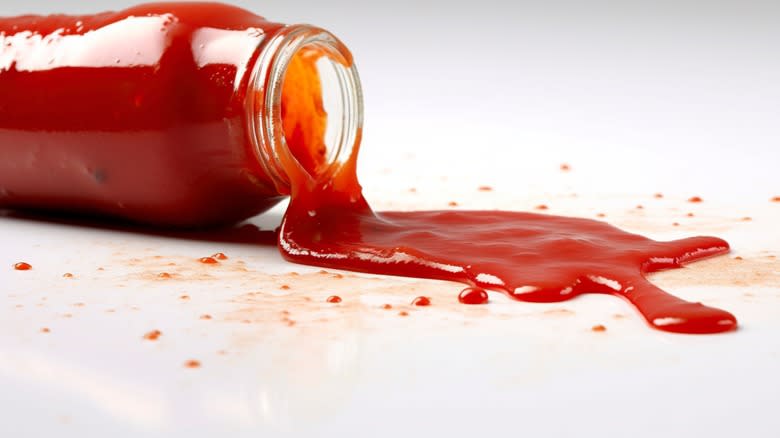
If you have a white or light-colored countertop, you'll be familiar with the persistent fear of irreparably staining it. You may even go so far as to cut out certain foods from your menu, like beets, pomegranate, or turmeric -- which are all items that, if left on certain surfaces for even a few minutes, can leave an indelible mark.
But you don't have to worry about staining your countertops if you have distilled white vinegar on your side. Just dilute it with water, spread it on the surface, and return a few minutes later to wipe it down. You'll see that most stains won't be able to stand up to the acidic nature of vinegar. As a bonus, you can use this method on other household objects as well, like clothes, upholstery, rugs, and even your hands. If you're using it to remove sticky juice or food residue from your fingers, you don't even need to dilute the vinegar with water.
Deep-Clean Your Cruciferous Veggies With Vinegar
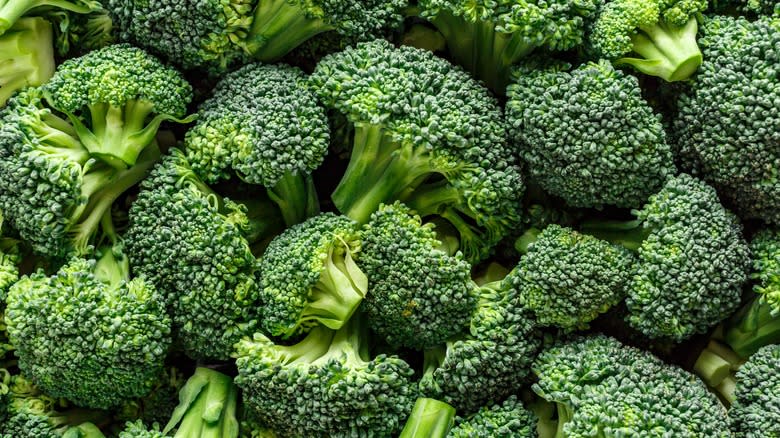
Certain cruciferous produce, like broccoli and cauliflower, are rife with little nooks and crannies. Who knows what kinds of mold, bacteria, or critters have taken up residence in there? The best way to be sure you've taken care of all stragglers is to deep clean your veggies with a vinegar and water mixture. Soak the produce for about two minutes before rinsing it well. For best results, divide the broccoli or cauliflower into smaller florets before you soak them to get into all of the crevasses.
Meanwhile, you can deep clean a cauliflower with salt and vinegar while also getting rid of yucky microbes and aphids. Salt and vinegar on their own can both remove unsavory items from your vegetables, so when put together, they become nearly invincible. Although cauliflower and broccoli can also be cleaned with water and a brush, it's not usually ideal to scrub down a vegetable with an abrasive cloth.
Shine Your Stainless Steel
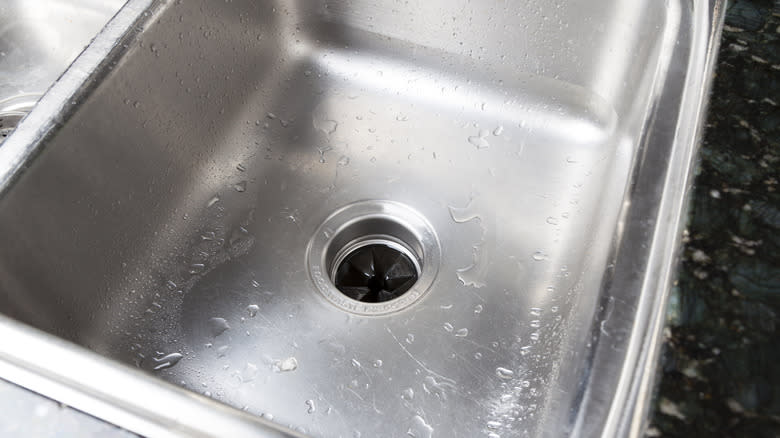
One of the great benefits of stainless steel is that it's quick and easy to clean. Usually, it just requires a swift wipe-down to get the job done. But for those instances where this is not enough, there is apple cider vinegar. Mix it with water and apply it to any stainless steel surface or object in your kitchen using a soft cloth. Doing this regularly will help prevent build-up, and you can also take advantage of the vinegar and do one big clean to remove any pesky debris or food residue. Just be sure to rinse everything with pure water afterward. Otherwise, the leftover vinegar can create streaks and a lingering acidic smell.
Also, remember that stainless steel is not entirely immune to the corrosive effects of vinegar, meaning that you must wash away the substance as soon as possible. In the same vein, avoid using pure vinegar and instead dilute it with equal parts water.
Keep Your Microwave Fresh And Spotless
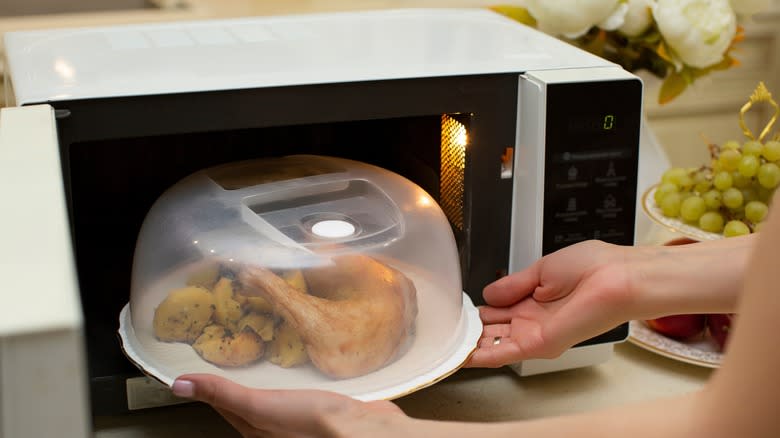
If you've ever heated up a meal in an office microwave, you know these contraptions can get pretty stinky. The same is true for your home microwave, especially if you don't get around to cleaning it that often. Food splatters all over the walls, not to mention the fact that heating up food in confined spaces will lead to powerful odors.
Fix all of that with a bit of apple cider vinegar. Mix it with water and place your solution in a microwaveable container inside the appliance. Heat it on high for a few minutes or until steam starts to appear. This should be enough to dislodge food splatters from the walls, making it easy for you to just wipe down any gross bits without encountering resistance. Leave the door open after this process to allow lingering odors to dissipate. Once the food has been cleaned off, the microwave should start to smell fresh again.
Repel Insects With Apple Cider Vinegar
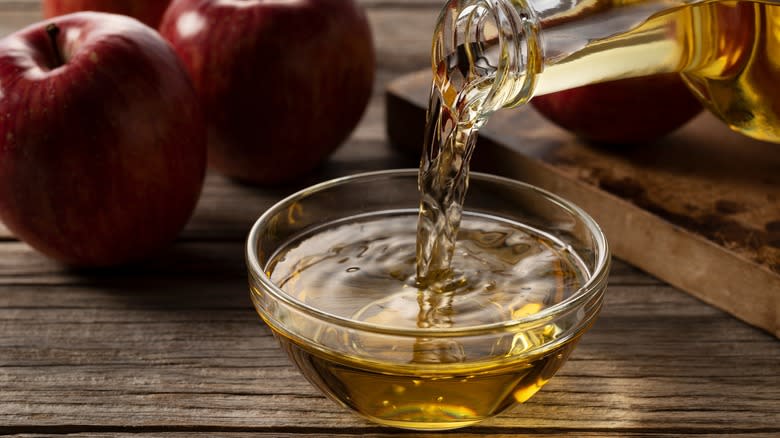
Although humans may enjoy consuming vinegar in small quantities in their salads or soups, large amounts definitely turn us off -- primarily due to the acidic flavor. The same is true for insects -- and the effect is amplified due to the animal's small size. As a result, a little vinegar can have a significant repellent effect on insects like ants and gnats.
Next time you think your kitchen is suffering from an insect invasion, use this simple vinegar hack. Mix water and vinegar together and utilize it to wipe down the areas that seem to be attracting the most critters. You can also make a trap for gnats and fruit flies with apple cider vinegar, which has a sweet, attractive scent to the bugs. Once you pour some dish soap into the vinegar, cover it with plastic wrap, and poke some holes in it, flies coming to investigate will get trapped when they land under the plastic lid.
Clean The Garbage Disposal Unit
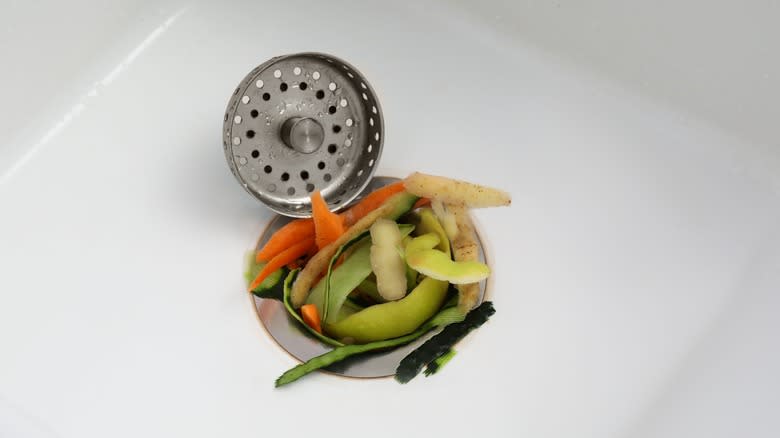
There's no denying that garbage disposal units are handy. When you have leftover food on your plate, it's just easier to dump everything into the sink before putting it in the dishwasher. It makes it especially easy to clean up after a large group of people. The problem is that as garbage disposal units are processing all that food, they're also absorbing odors, which in turn causes the unit to get super stinky.
There are several ways to deal with this problem, including tossing in some citrus peels to mask the bad smells. But this can cause clogging issues for your garbage disposal, septic tank, or both. Instead, we recommend using a method that leaves no trace. Freeze some vinegar in your ice cube trays and drop those frozen cubes into your garbage disposal. This will allow the vinegar to get into all the nooks and crannies of your unit without requiring that you stick your hand down it.
Read the original article on Tasting Table.

